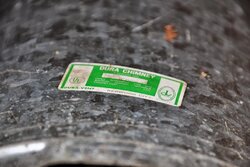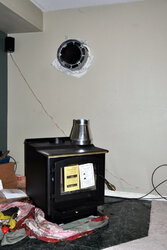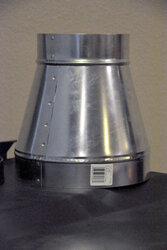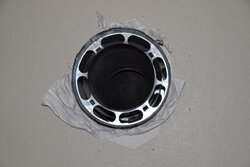We just replaced a malm firedrum freestanding fireplace which connected to our 9" chimney, with an 6" Englander stove.
I've been having a hard time finding a 6' to 9" adapter. In calling the local stove shops nobody says that anyone makes a 9" chimney. The Chimney is a 3 walled 9" Duravent chimney that's probably as old as the house (1980) but I can't find anything on the duravent website about 9" chimneys.
Does anybody know of any woodstove 6" to 9" adapters?
I did find a 6" to 9" 'stovepipe' reducer but when it arrived it looks like its made from galvanized steel which I'm hesitant to use with a wood stove (poisonous zinc oxide gases)
Any suggestions?
Does anyone think I should just use adapter I already have?
Here's a picture of the outside of the chimney (it's housed in a wooden chase)
Here's the stove chimney and current (I believe galvanized) adapter.

Here's a close up of the adapter I bought online as a "stovepipe" adapter.
the label says GV1269
(http://www.essentialhardware.com/imperial-manufacturing-gv12699x6-311p-galvanized-increaser-9-x-6-236646.html)

And here's the chimney the inner pipe is 9" The outside chimney is also 9"

I've been having a hard time finding a 6' to 9" adapter. In calling the local stove shops nobody says that anyone makes a 9" chimney. The Chimney is a 3 walled 9" Duravent chimney that's probably as old as the house (1980) but I can't find anything on the duravent website about 9" chimneys.
Does anybody know of any woodstove 6" to 9" adapters?
I did find a 6" to 9" 'stovepipe' reducer but when it arrived it looks like its made from galvanized steel which I'm hesitant to use with a wood stove (poisonous zinc oxide gases)
Any suggestions?
Does anyone think I should just use adapter I already have?
Here's a picture of the outside of the chimney (it's housed in a wooden chase)

Here's the stove chimney and current (I believe galvanized) adapter.

Here's a close up of the adapter I bought online as a "stovepipe" adapter.
the label says GV1269
(http://www.essentialhardware.com/imperial-manufacturing-gv12699x6-311p-galvanized-increaser-9-x-6-236646.html)

And here's the chimney the inner pipe is 9" The outside chimney is also 9"




 I may have used it instead.
I may have used it instead.